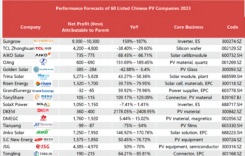PVTIME – The 100+MW PV project in Pangasinan, Philippines, has suffered significant damage from Typhoon Egay (international name Doksuri), which intensified into a super typhoon upon making landfall. This event has raised concerns among insiders of the Philippine photovoltaic industry about the reliability of oversized photovoltaic modules. Consequently, more PV power plant project owners are exploring the global mainstream market and gradually relying on mainstream products.
The Philippines possesses abundant geothermal, hydropower, solar and wind power resources, and is one of the first countries in Asia which utilizes renewable energy. With the steady decline in the cost of solar equipment and the short installation and commissioning time required for solar projects, Philippine power plant owners and the industry are increasingly embracing solar systems. The projected capacity of the utility PV market in the Philippines is expected to reach approximately 1,624MW by 2023, followed by a remarkable surge in growth in 2024, with the utility market capacity reaching up to 2,327MW. However, under the thriving photovoltaic market in the Philippines, there exist certain underlying concerns. The Philippines, known as “Land the Thousand Islands”, is located in a region prone to frequent typhoons, experiencing approximately 20 typhoons annually. Consequently, PV module are required high level of stability and reliability. However, in contrast to the global market, the pursuit of high power currently dominates the oversized module market in the Philippines. This is also exposed photovoltaic power generation projects to losses caused by typhoon damage.
The project is expected to generate an annual electricity supply of 250 million kWh to the local grid upon its completion in 2023. This project fully utilized oversized PV modules of the 210-66c (up to 3.1m²). Unfortunately, due to the impact of super Typhoon Egay, certain photovoltaic modules were adversely affected. As reported by the site engineer overseeing this project, these fully installed and securely fastened modules were still unable to withstand the forceful winds and consequently collided with other modules on-site, resulting in significant disruption. The exact number of damaged PV modules remains unknown.

In fact, this is not the first time that the Philippine photovoltaic power generation industry has suffered power plant damage in extreme weather this year. In May, another photovoltaic power generation project also suffered heavy damage by strong winds. The project also utilized oversized modules of 210-66c version, the strong wind caused the photovoltaic array of the super module to be blown over. leading to numerous collapses and rendering a large number of photovoltaic brackets and components non-functional.

According to industry experts, the 210-66c version of the oversized module offers a larger wind blocking area compared to mainstream 182 products in windy conditions, but also the back of the module may experience significant pressure which can potentially lead to damage. The risk of rack resonance instability is heightened simultaneously. The surge in such incidents has prompted power station owners to reassess their choice of oversized modules, considering the potential accidents caused by extreme weather and unforeseen losses. In the global mainstream market, the 182 size is emerged as the optimal choice for PV modules, striking a balance between value and risk, with its widespread adoption and industry validation over the past three years, the 182 size is expected to hold 80% of the market share by 2023, which also shows the industry’s consensus on module size.
As is widely recognized, the Philippine PV industry has a huge potential for growth, and the National Renewable Energy Program (NREP) 2020-2040 has set targets of achieving a renewable energy share of 35% and 50% in the power generation mix by 2030 and 2040 respectively. Thereby presenting significant opportunities for the development of the Philippine renewable energy industry. The Philippine renewable energy market is expected to grow at a CAGR exceeding 8.0% from 2022-2027, In addition, the Philippine Department of Energy (DOE) lifted the restriction on foreign ownership, which previously limited it to no more than 40% in the development and utilization of renewable energy in 2022. This regulatory change is expected to attract more foreign investors and drive the rapid development and expansion of the Philippine PV industry. With the booming development of the Philippine PV power generation industry, an increasing number of new power plant projects have commenced construction. However, following numerous accidents caused by extreme weather conditions and the costly lessons learned from oversized module destruction, there has been a growing awareness among customers regarding the potential risks associated with oversized modules. Consequently, they are now transitioning towards adopting global mainstream product specifications and sizes for their new projects. Considering the geographical environment of the Philippines and taking into account investment as well as operation and maintenance aspects of PV power plants, it is likely that there will be an adjustment in favor of high-power solutions within the Philippine market.











